Failure Patterns of Transmission Tower-Line System Caused by Landslide Events
Abstract
:1. Introduction
2. The Yanzi Landslide
3. Wind Load Formation
4. Dynamic Response Analysis Method of the Tower-Line Structure
5. Collapse Analysis of the Tower-Line System under Wind and Landslide Action
5.1. Numerical Model of the Tower-Line Structure
5.2. Load Cases
5.3. Progressive Collapse under Case 1
5.4. Progressive Collapse Simulation under Case 2
6. Discussion
7. Conclusions
Author Contributions
Funding
Data Availability Statement
Conflicts of Interest
References
- Wu, D.; Zheng, X.; Xu, Y.; Olsen, D.; Xia, B.; Singh, C.; Xie, L. An open-source extendable model and corrective measure assessment of the 2021 texas power outage. Adv. Appl. Energy 2021, 4, 100056. [Google Scholar] [CrossRef]
- Ivanova, I. Texas Winter Storm Costs Could Top $200 Billion—More Than Hurricanes Harvey and Ike. 2021. Available online: https://www.cbsnews.com/news/texas-winter-storm-uri-costs (accessed on 1 August 2022).
- Tengle, J.; Renault, M. Suspected Hypothermia Deaths in Homes Mount in Texas. 2021. Available online: https://apnews.com/article/houston-hypothermia-weather-conroe-texas-8323ab5f5c1612e632f7f2e6c2c20358 (accessed on 1 August 2022).
- Chang, J. What Happened behind the Nationwide Power Cuts? 2021. Available online: https://m.bjnews.com.cn/detail/163266456914638.html (accessed on 1 August 2022).
- Liu, S.; Yin, K.; Zhou, C.; Gui, L.; Liang, X.; Lin, W.; Zhao, B. Susceptibility Assessment for Landslide Initiated along Power Transmission Lines. Remote Sens. 2021, 13, 5068. [Google Scholar] [CrossRef]
- State Grid Equipment Department and China Electric Power Research Institute. Investigation Report on Geological Hazards of Power Transmission Lines (Yearly Report), 2017–2021; State Grid Equipment Department and China Electric Power Research Institute: Beijing, China, 2021. [Google Scholar]
- Roering, J.J.; Kirchner, J.W.; Dietrich, W.E. Characterizing structural and lithologic controls on deep-seated landsliding: Implications for topographic relief and landscape evolution in the Oregon Coast Range, USA. Geol. Soc. Am. Bull. 2005, 117, 654–668. [Google Scholar] [CrossRef]
- Xu, C.; Dai, F.C.; Yao, X.; Chen, J.; Tu, X.B.; Sun, Y.; Wang, Z.Y. GIS-based landslide susceptibility assessment using analytical hierarchy process in Wenchuan earthquake region. Chin. J. Rock Mech. Eng. 2009, 28, 3978–3985. [Google Scholar]
- Chigira, M.; Wu, X.; Inokuchi, T.; Wang, G. Landslides induced by the 2008 Wenchuan earthquake, Sichuan, China. Geomorphology 2010, 118, 225–238. [Google Scholar] [CrossRef]
- Qi, S.; Xu, Q.; Lan, H.; Zhang, B.; Liu, J. Spatial distribution analysis of landslides triggered by 2008.5. 12 Wenchuan Earthquake, China. Eng. Geol. 2010, 116, 95–108. [Google Scholar] [CrossRef]
- Guo, D.; Hamada, M. Qualitative and quantitative analysis on landslide influential factors during Wenchuan earthquake: A case study in Wenchuan County. Eng. Geol. 2013, 152, 202–209. [Google Scholar] [CrossRef]
- TAKAHASHI, T. Estimation of potential debris flows and their hazardous zones: Soft countermeasures for a disaster. Nat. Disaster Sci. 1981, 3, 57–89. [Google Scholar]
- Rickenmann, D. Empirical relationships for debris flows. Nat. Hazards 1999, 19, 47–77. [Google Scholar] [CrossRef]
- Rickenmann, D. Runout prediction methods. In Debris-Flow Hazards and Related Phenomena; Springer: Berlin/Heidelberg, Germany, 2005; pp. 305–324. [Google Scholar]
- McDougall, S.D.; Hungr, O. Objectives for the development of an integrated three-dimensional continuum model for the analysis of landslide runout. In Debris-Flow Hazards Mitigation: Mechanics, Prediction, and Assessment, Proceedings of the 3rd International DFHM Conference, Davos, Switzerland, Millpress 10–12 September 2003; Rickenmann, D., Chen, C.L., Eds.; Ios Press Inc.: Amsterdam, The Netherlands, 2003; pp. 481–490. [Google Scholar]
- Guo, D.; Hamada, M.; He, C.; Wang, Y.; Zou, Y. An empirical model for landslide travel distance prediction in Wenchuan earthquake area. Landslides 2014, 11, 281–291. [Google Scholar] [CrossRef]
- Tian, L.; Bi, W.; Liu, J.; Dong, X.; Xin, A. Seismic and collapse analysis of a UHV transmission tower-line system under cross-fault ground motions. Earthq. Struct. 2020, 19, 445–457. [Google Scholar]
- Tian, L.; Pan, H.; Qiu, C.; Ma, R.; Yu, Q. Wind-induced collapse analysis of long-span transmission tower–line system considering the member buckling effect. Adv. Struct. Eng. 2019, 22, 30–41. [Google Scholar] [CrossRef]
- Zheng, H.D.; Fan, J. Progressive collapse analysis of a truss transmission tower-line system subjected to downburst loading. J. Constr. Steel Res. 2022, 188, 107044. [Google Scholar] [CrossRef]
- Kassem, M.M.; Beddu, S.; Qi Min, W.; Tan, C.G.; Mohamed Nazri, F. Quantification of the Seismic Behavior of a Steel Transmission Tower Subjected to Single and Repeated Seismic Excitations Using Vulnerability Function and Collapse Margin Ratio. Appl. Sci. 2022, 12, 1984. [Google Scholar] [CrossRef]
- Li, J.; Gao, F.; Wang, L.; Ren, Y.; Liu, C.; Yang, A.; Yan, Z.; Jiang, T.; Li, C. Collapse Mechanism of Transmission Tower Subjected to Strong Wind Load and Dynamic Response of Tower-Line System. Energies 2022, 15, 3925. [Google Scholar] [CrossRef]
- Fu, X.; Li, H.N.; Li, G.; Dong, Z.Q. Fragility analysis of a transmission tower under combined wind and rain loads. J. Wind. Eng. Ind. Aerodyn. 2020, 199, 104098. [Google Scholar] [CrossRef]
- Guan, R.; Xiang, C.; Jia, Z. Anti-Wind Experiments and Damage Prediction of Transmission Tower under Typhoon Conditions in Coastal Areas. Energies 2022, 15, 3372. [Google Scholar] [CrossRef]
- Zhou, Y.; Sheng, Q.; Chen, J.; Li, N.; Fu, X.; Zhou, Y. The failure mode of transmission tower foundation on the landslide under heavy rainfall: A case study on a 500-kV transmission tower foundation on the Yanzi landslide in Badong, China. Bull. Eng. Geol. Environ. 2022, 81, 125. [Google Scholar] [CrossRef]
- Wang, F.Y.; Xu, Y.L.; Qu, W.L. Multi-scale failure analysis of transmission towers under downburst loading. Int. J. Struct. Stab. Dyn. 2018, 18, 1850029. [Google Scholar] [CrossRef]
- Zheng, H.D.; Zhang, B.; Wang, S.B.; Zhou, G.Z. Effects of Blade Numbers on Wind-Induced Fatigue Lives of Straight-Bladed Vertical-Axis Wind-Turbine Tower Bases. Metals 2022, 12, 321. [Google Scholar] [CrossRef]
- International Electrotechnical Commission. Wind Turbines-Part 1: Design Requirements. IEC 614001 Ed. 3; International Electrotechnical Commission: Geneva, Switzerland, 2006. [Google Scholar]
- Higham, N.J. Analysis of the Cholesky Decomposition of a Semi-Definite Matrix; Oxford University Press: Oxford, UK, 1990. [Google Scholar]
- Zheng, H.D.; Fan, J.; Long, X.H. Analysis of the seismic collapse of a high-rise power transmission tower structure. J. Constr. Steel Res. 2017, 134, 180–193. [Google Scholar] [CrossRef]
- Zheng, H.D.; Fan, J. Phenomenological hysteretic model for steel braces including inelastic postbuckling and low-cycle fatigue prediction. J. Struct. Eng. 2019, 145, 04019037. [Google Scholar] [CrossRef]
- Yang, S.C.; Hong, H.P. Nonlinear inelastic responses of transmission tower-line system under downburst wind. Eng. Struct. 2016, 123, 490–500. [Google Scholar] [CrossRef]
- Long, X.; Wang, W.; Fan, J. Collapse analysis of transmission tower subjected to earthquake ground motion. Model. Simul. Eng. 2018, 2018, 2687561. [Google Scholar] [CrossRef]
- Zheng, H.D.; Fan, J. Analysis of the progressive collapse of space truss structures during earthquakes based on a physical theory hysteretic model. Thin-Walled Struct. 2018, 123, 70–81. [Google Scholar] [CrossRef]
- Lewis, W.J.; Jones, M.S.; Rushton, K.R. Dynamic relaxation analysis of the non-linear static response of pretensioned cable roofs. Comput. Struct. 1984, 18, 989–997. [Google Scholar] [CrossRef]
- Zheng, X.Y.; Zheng, H.D.; Lei, Y.; Chen, H. Nonlinear stochastic responses of a newly developed floating wind-solar-aquaculture system. Ocean. Eng. 2021, 241, 110055. [Google Scholar] [CrossRef]
- Zheng, H.D.; Zheng, X.Y.; Lei, Y.; Li, D.A.; Ci, X. Experimental validation on the dynamic response of a novel floater uniting a vertical-axis wind turbine with a steel fishing cage. Ocean. Eng. 2022, 243, 110257. [Google Scholar]
- Duan, Y.F.; Wang, S.M.; Yau, J.D. Vector form intrinsic finite element method for analysis of train–bridge interaction problems considering the coach-coupler effect. Int. J. Struct. Stab. Dyn. 2019, 19, 1950014. [Google Scholar] [CrossRef]
- Higham, D.J.; Higham, N.J. MATLAB Guide; Society for Industrial and Applied Mathematics: Philadelphia, PA, USA, 2016. [Google Scholar]
- Veletsos, A.S.; Darbre, G.R. Dynamic stiffness of parabolic cables. Earthq. Eng. Struct. Dyn. 1983, 11, 367–401. [Google Scholar] [CrossRef]
- Loredo-Souza, A.M.; Davenport, A.G. The effects of high winds on transmission lines. J. Wind. Eng. Ind. Aerodyn. 1998, 74, 987–994. [Google Scholar] [CrossRef]
- Takeuchi, M.; Maeda, J.; Ishida, N. Aerodynamic damping properties of two transmission towers estimated by combining several identification methods. J. Wind. Eng. Ind. Aerodyn. 2010, 98, 872–880. [Google Scholar] [CrossRef]






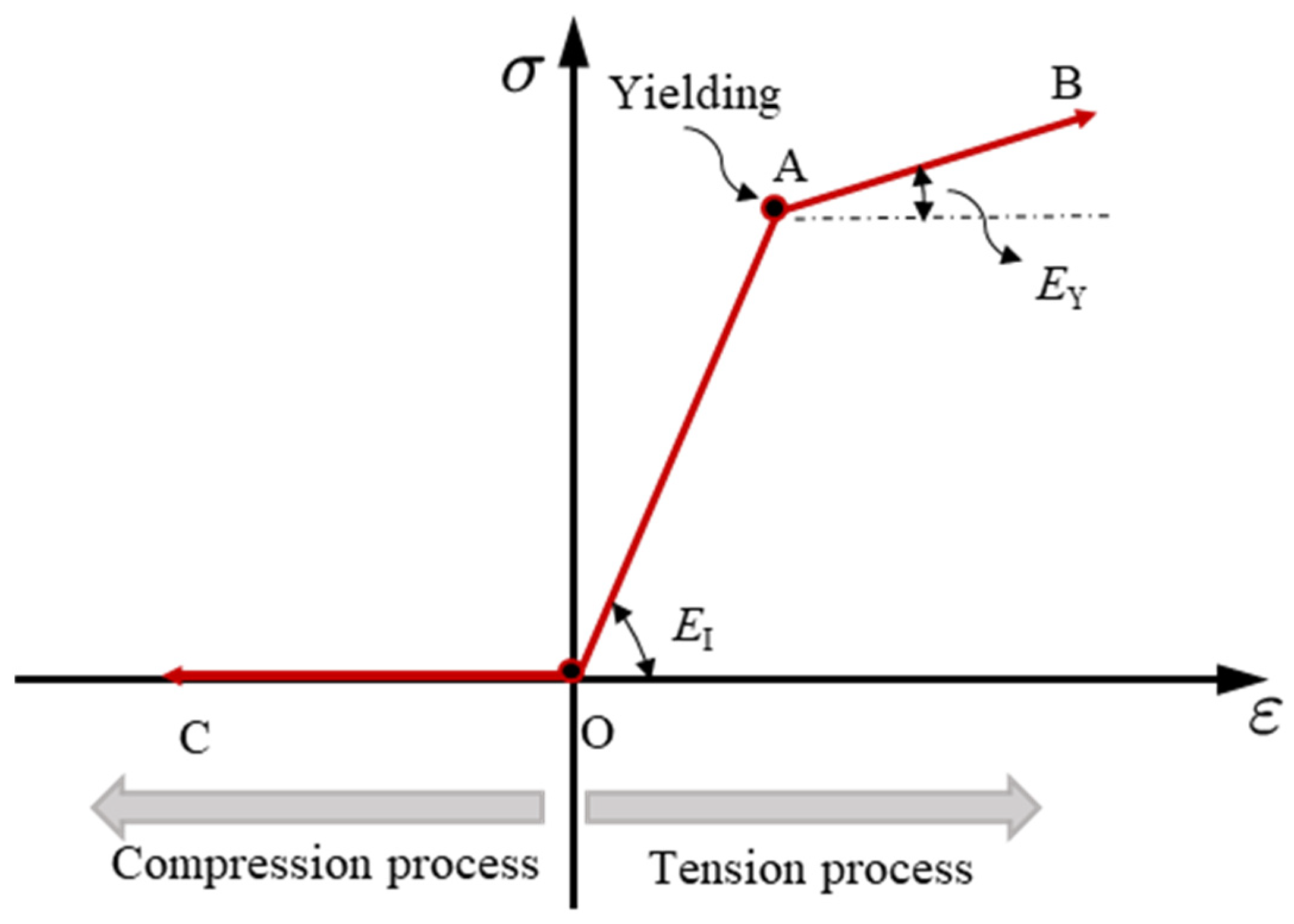
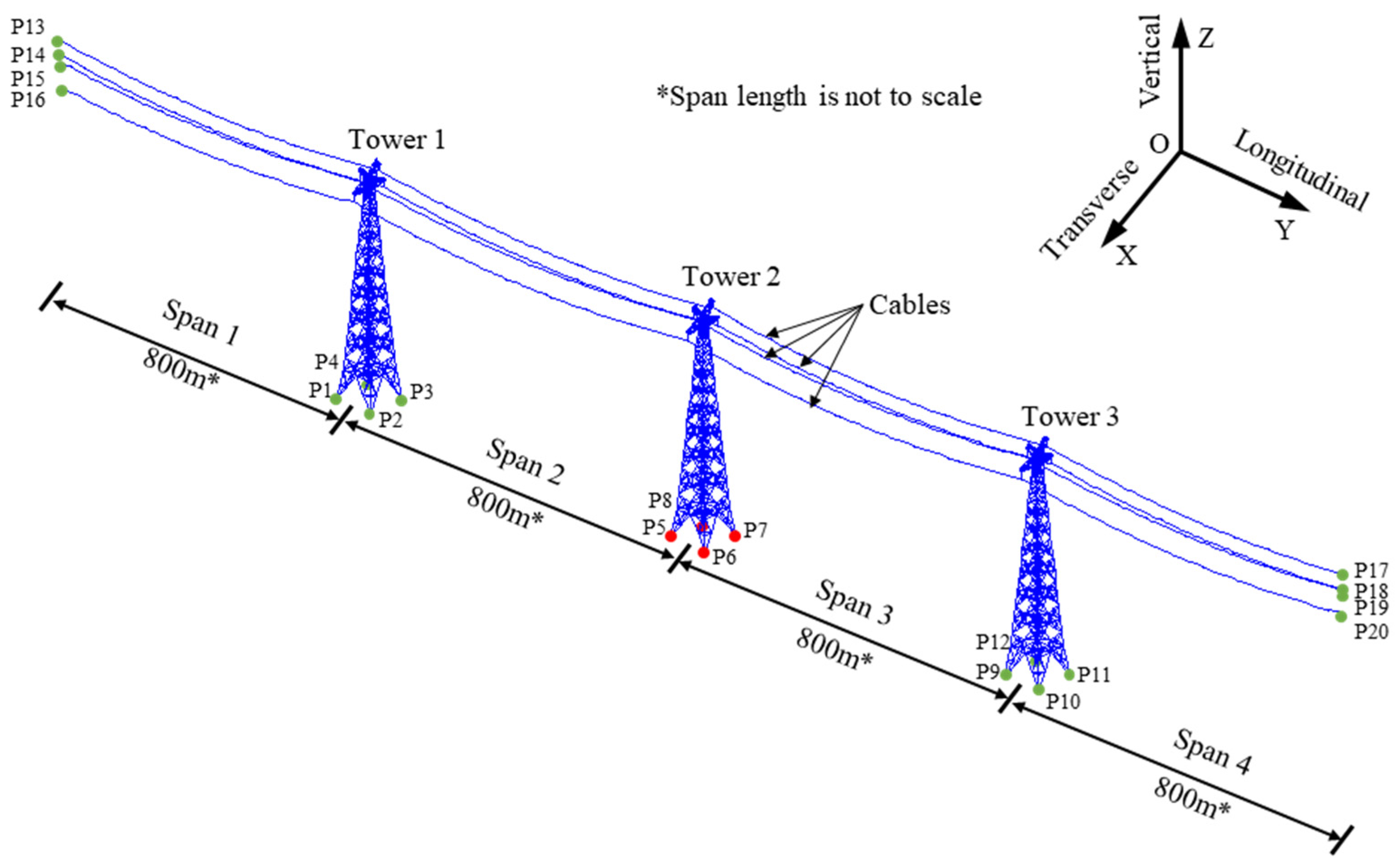
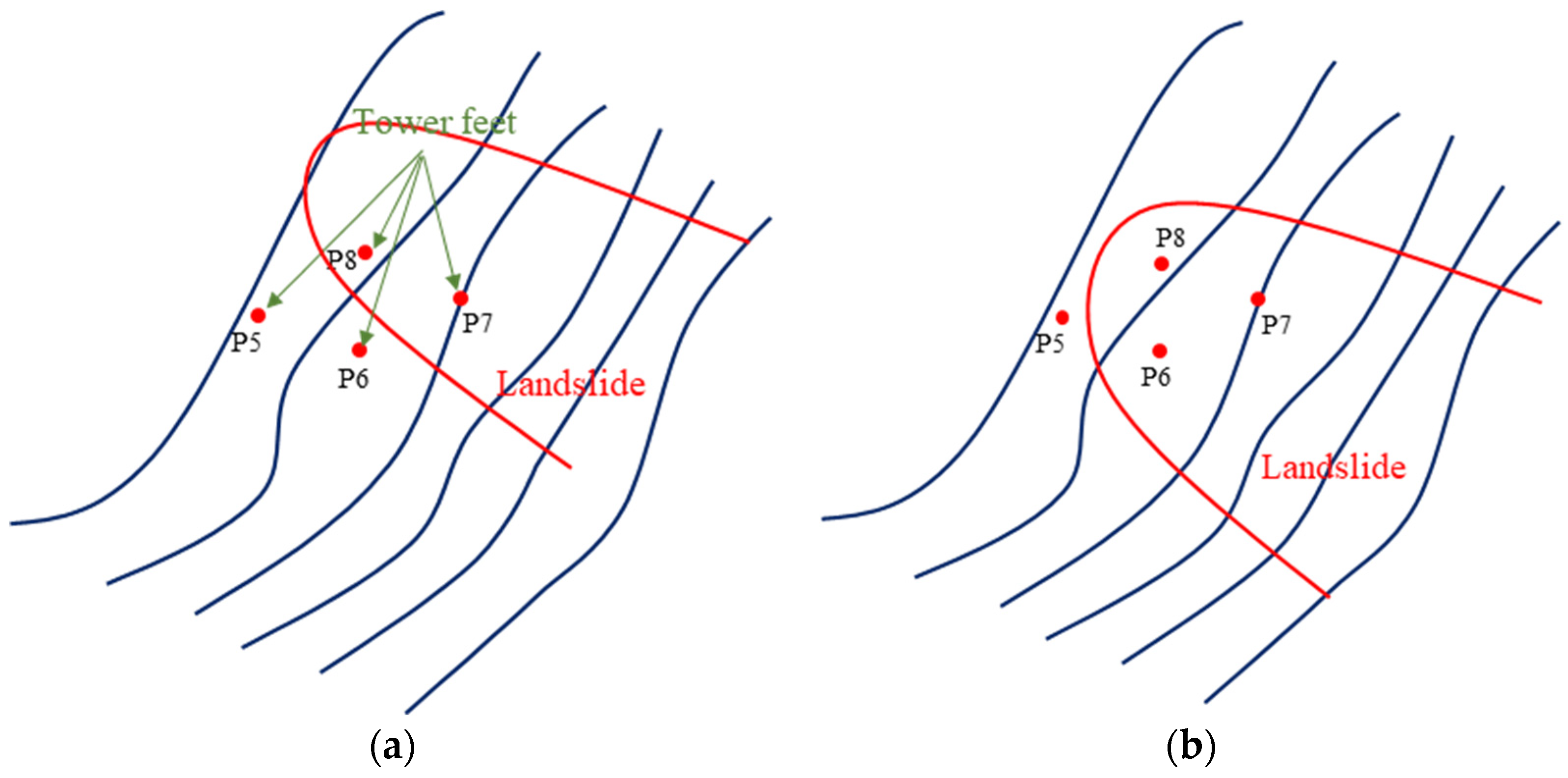


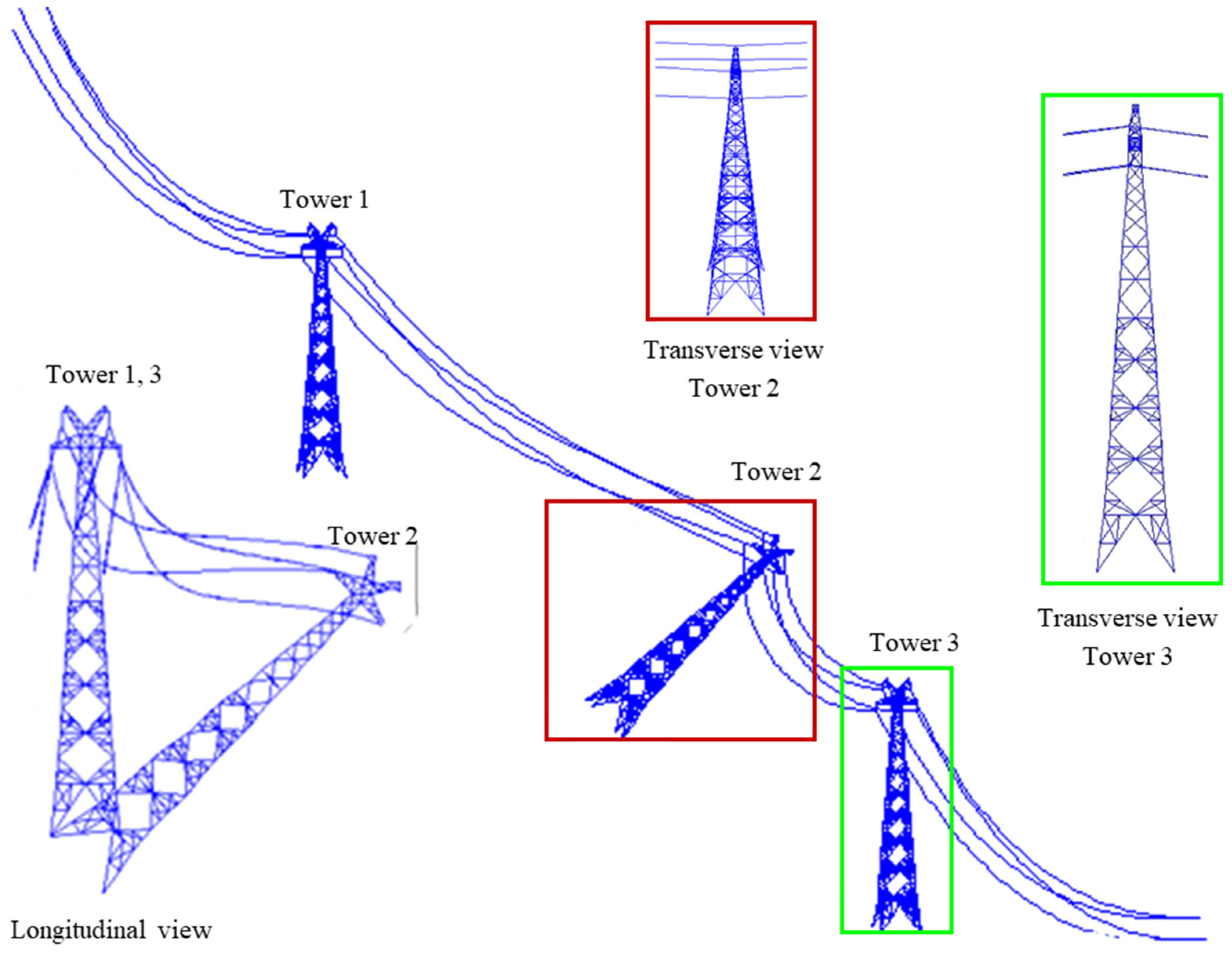

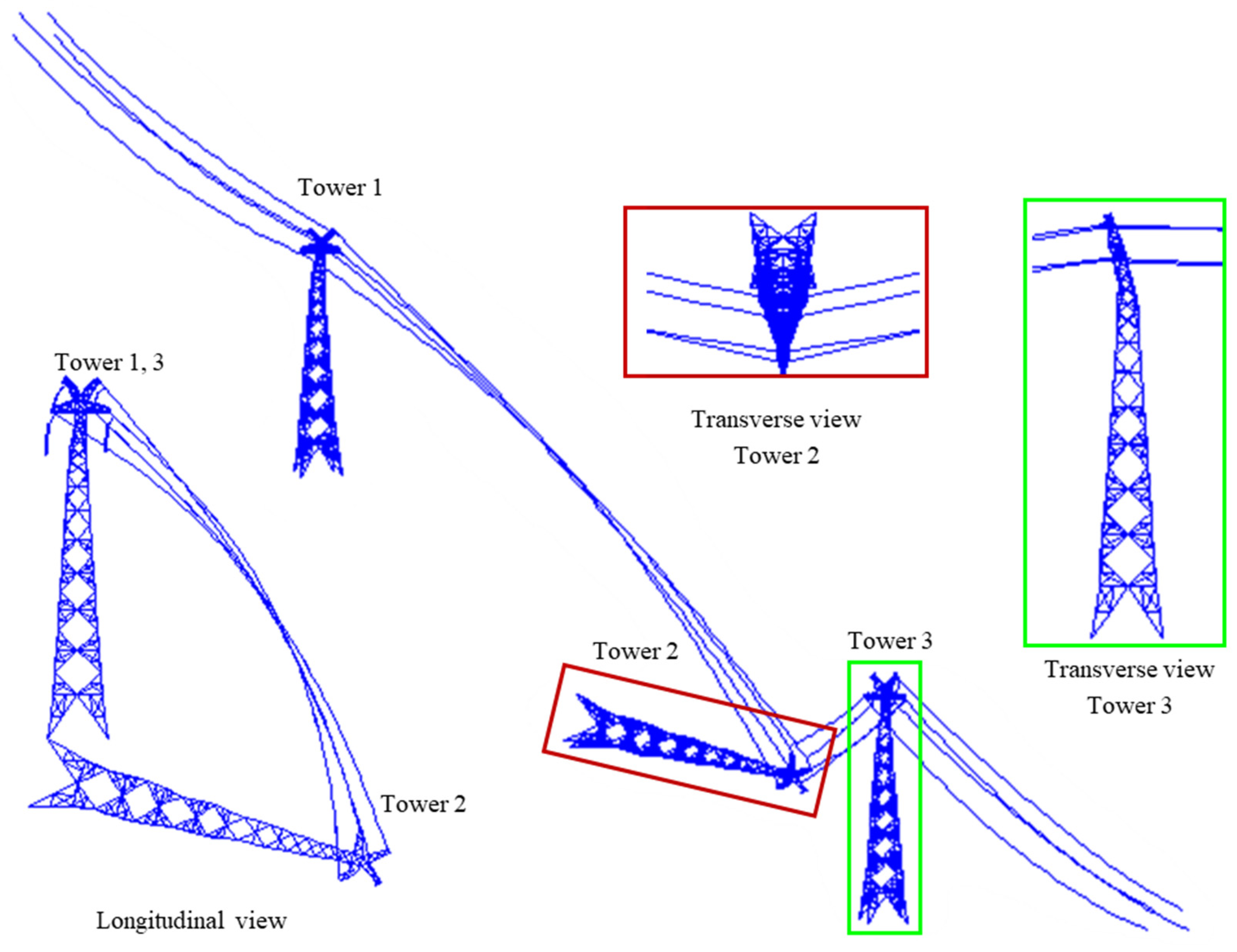


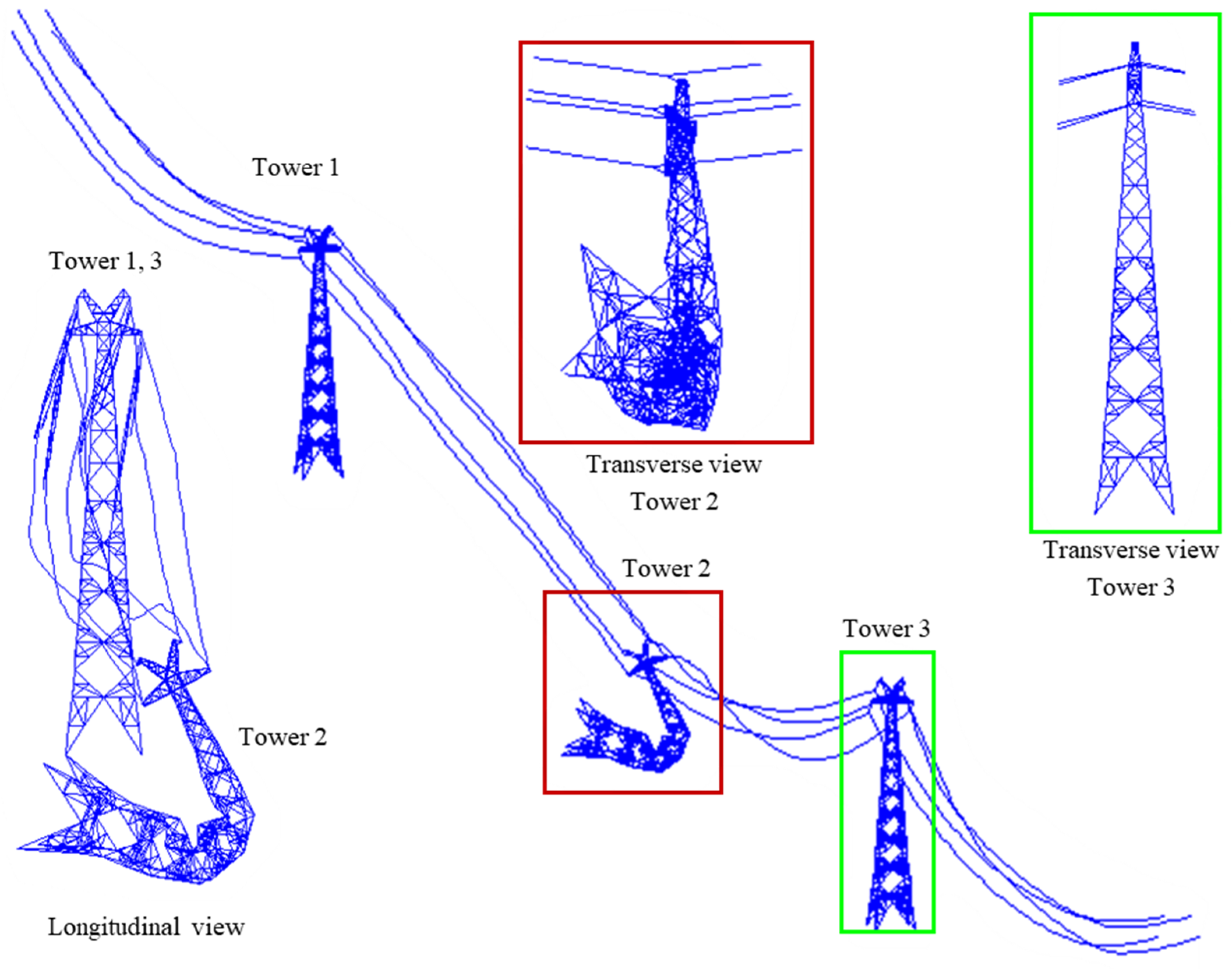
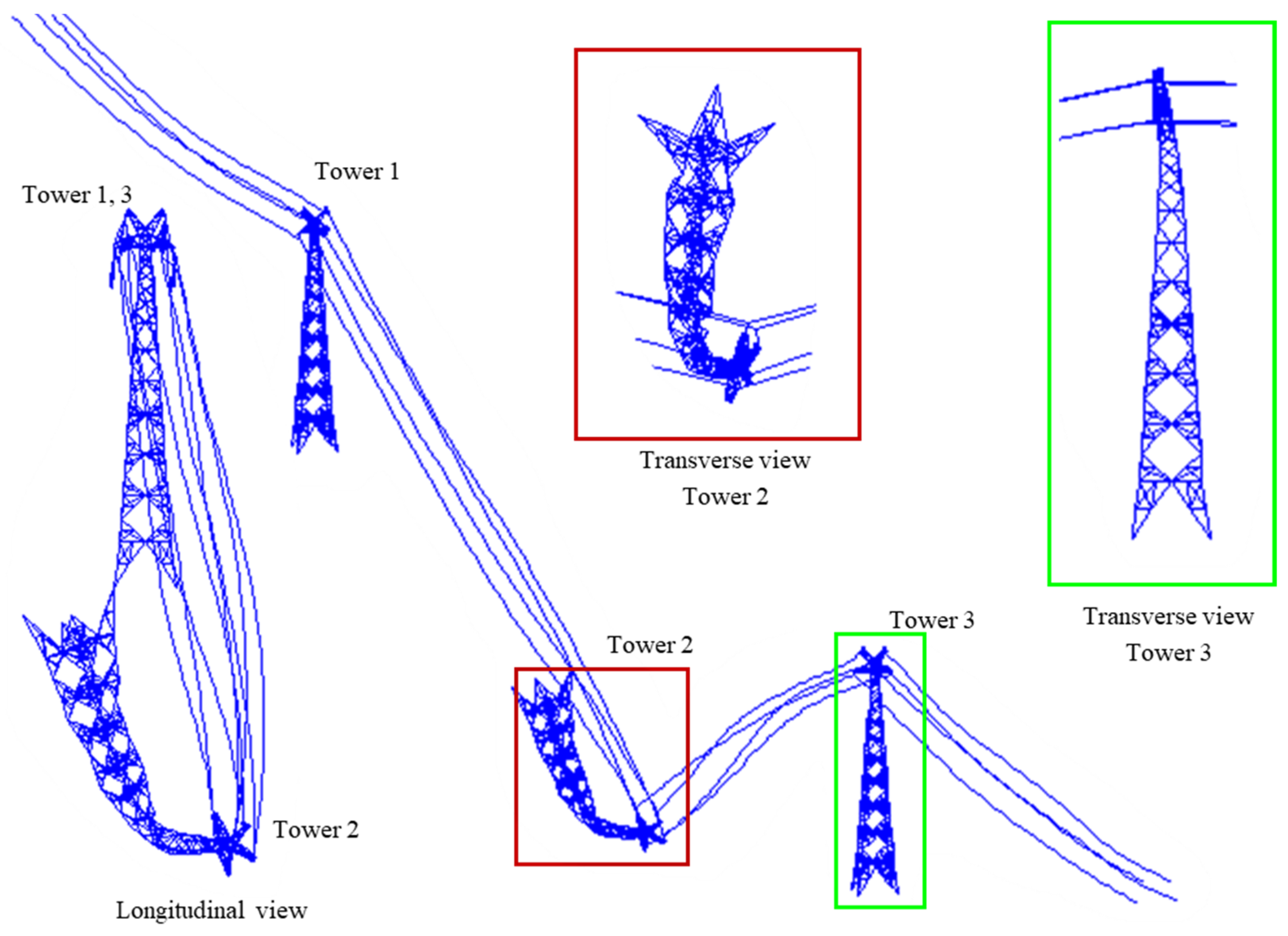
| Parameter | Value |
|---|---|
| Yield stress (MPa) | 235 |
| Elastic modulus (GPa) | 206 |
| Mass density (kg/m3) | 7800 |
| Poisson’s ratio | 0.3 |
Publisher’s Note: MDPI stays neutral with regard to jurisdictional claims in published maps and institutional affiliations. |
© 2022 by the authors. Licensee MDPI, Basel, Switzerland. This article is an open access article distributed under the terms and conditions of the Creative Commons Attribution (CC BY) license (https://creativecommons.org/licenses/by/4.0/).
Share and Cite
Yu, H.; Li, H.; Zhang, Z.-Q.; Zhang, G.-F.; Wang, D.-H.; Zheng, H.-D. Failure Patterns of Transmission Tower-Line System Caused by Landslide Events. Energies 2022, 15, 7155. https://doi.org/10.3390/en15197155
Yu H, Li H, Zhang Z-Q, Zhang G-F, Wang D-H, Zheng H-D. Failure Patterns of Transmission Tower-Line System Caused by Landslide Events. Energies. 2022; 15(19):7155. https://doi.org/10.3390/en15197155
Chicago/Turabian StyleYu, Hong, Hao Li, Zhi-Qiang Zhang, Gui-Feng Zhang, Da-Hai Wang, and Hua-Dong Zheng. 2022. "Failure Patterns of Transmission Tower-Line System Caused by Landslide Events" Energies 15, no. 19: 7155. https://doi.org/10.3390/en15197155
APA StyleYu, H., Li, H., Zhang, Z.-Q., Zhang, G.-F., Wang, D.-H., & Zheng, H.-D. (2022). Failure Patterns of Transmission Tower-Line System Caused by Landslide Events. Energies, 15(19), 7155. https://doi.org/10.3390/en15197155






